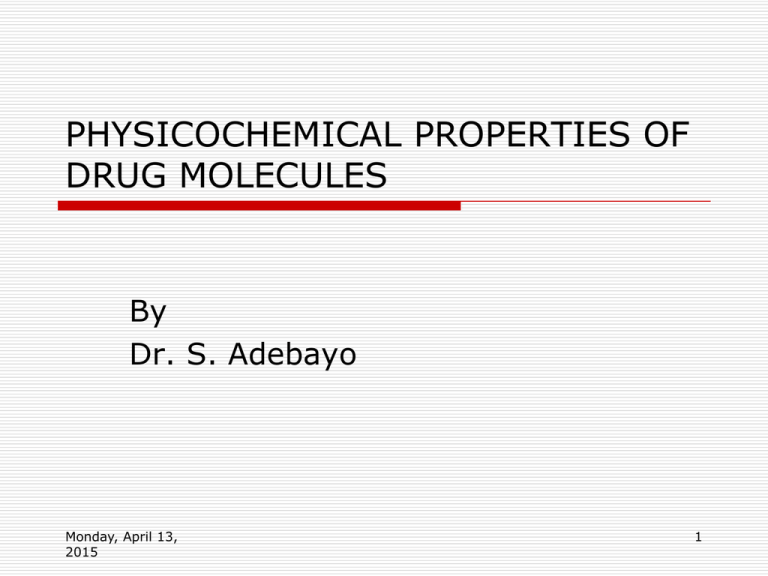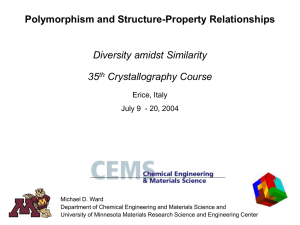PHYSICOCHEMICAL PROPERTIES OF DRUG MOLECULES
advertisement

PHYSICOCHEMICAL PROPERTIES OF DRUG MOLECULES By Dr. S. Adebayo Monday, April 13, 2015 1 Polymorphism A function of internal arrangement/structure of crystalline solids Polymorphic substances exist in more than one packing arrangement Monday, April 13, 2015 2 McCrone’s Law states that every compound has different polymorphic forms, and that, in general,the number of forms known for a given compound is proportional to the time and money spent in research on that compound. Monday, April 13, 2015 3 Polymorphism Occurrence of more than one morphic form Monotropic Enantiotropic Amorphism Monday, April 13, 2015 4 Crystal habit The outward appearance of a crystal Independent of morphic forms Can be defined on the basis of variations on the themes of 7 systems: Cubic, tetragonal, orthorhombic, monoclinic, riclinic, trigonal, hexagonal Monday, April 13, 2015 5 Angles & lengths that describe crystal habits Crystal Angle of axes Length of axes Examples Cubic (regular) α = β = γ = 90º x =y =z NaCl Tetragonal α = β = γ = 90º x =y ≠z NiSO4 Orthorhombic α = β = γ = 90º x ≠y ≠z K2MNO4 Monoclinic α = β = γ ≠ 90º x ≠y ≠z Sucrose Triclinic (asymmetric) α ≠β ≠ γ ≠ 90º x ≠y ≠z CuSO4 Trigonal (rhombohedral) α = β = γ ≠90º x =y =z NaNO3 Hexagonal Z at 90º to base - AgNO3 Monday, April 13, 2015 6 Vector illustration of Angles and lengths of axes that describe crystal habits z x α = between length & breadth y β = between breadth & height γ = between length & height Crystal Systems Monday, April 13, 2015 8 Crystal Morphology & Habit Monoclinic simple monoclinic Monday, April 13, 2015 centered monoclinic 10 Rhombohedral Monday, April 13, 2015 11 Tetragonal (Wulfenite) simple tetragonal Monday, April 13, 2015 body-centered tetragonal 12 Tetragonal Monday, April 13, 2015 13 Orthorhombic xtals basesimple centered body-centered face-centered orthorhombic orthorh orthorhombic orthorhombic ombic Monday, April 13, 2015 14 Orthorhombic (Danburite) Monday, April 13, 2015 15 Granular e.g. Tungstate (CaWO4) Monday, April 13, 2015 16 Acicular Monday, April 13, 2015 17 Monoclinic (Realgar) Monday, April 13, 2015 18 Hexahedral (Vanadinite) Monday, April 13, 2015 19 SEM OF BREADFRUIT & CORN STARCH POWDERS (Adebayo & Itiola, 2005; 2008) Monday, April 13, 2015 20 Scanning Electron micrographs of (A) Bitter yam, (B) Chinese yam, (C) Round leaf yellow yam, (D) Sweet yam and (E) Negro yam (Riley, Adebayo et al (2008) Monday, April 13, 2015 21 Crystal habit and drug properties Changes in crystal habit can influence: dissolution rate, powder flow compressibility. Monday, April 13, 2015 can have significant effect on processability and use of dosage forms. 22 Crystal habit and drug properties … Effect on dissolution rate can be explained by the changes in surface to volume ratio Transition from regular to acicular (‘needle’) shape crystals (e.g. aspirin) may be reflected as poor flow property. Monday, April 13, 2015 23 Origin of Crystal Habit Habit is determined by the rate of growth of different faces of a crystal. Hence, it can be altered by changes in crystallization process. Generally, the fastest growing faces tend to grow out of existence: Will be the smallest faces on the final crystal the slowest growing faces will dominate the final structure. Monday, April 13, 2015 24 Origin of Crystal Habit … Solvent of crystallization – crystallizing solvent may preferentially favour interaction with different faces and consequently alter the crystal habit. Monday, April 13, 2015 25 Origin/changes in crystal habit The presence of impurities - may be caused by: impurities breakdown products synthetic mixture precursors in the crystallization a deliberate addition of impurities (e.g. SAAs) Monday, April 13, 2015 (Fairbrather, J. E. & Grant, JWD, 1974, JPP 30: 19p & JPP 31: 27p) 26 Crystal Defects Imperfections due to point defects or dislocations during packing of lattice Due to addition or accidental presence of low conc. of impurities Can cause major changes in: Ease of processing Chemical reactivity Dissolution Bioavailability Monday, April 13, 2015 27 Obtaining the right habit The preformulation scientist should consider the optimum form of habit Possibly influence crystallization procedures to ensure optimum properties are not serendipitous but rather a result of crystal engineering. Monday, April 13, 2015 28 Characterization of crystal habits Crystal habit & morphology can best be studied by microscopic techniques. Standard light microscopes fitted with polarizing filters and phase contrast facilities can allow easy examination of crystals and quantification of habit and size. Monday, April 13, 2015 29 Characterization of crystal habits… Studies on crystal properties generally involve standard tests such as: melting point to indicate crystal purity and crystal form thermal analysis. Crystal habit can be deduced from photomicrography For photomicrography, image may be enhanced by using polarized light. Scanning electron micrography. Monday, April 13, 2015 30 Optical isomers Preferred isomer should be identified Any other isomers are regarded as impurities Column based systems now available for determination Monday, April 13, 2015 31 Setting acceptance criteria for drug substance & drug products Monday, April 13, 2015 32 Concepts/Terminologies Relating to Crystalline Phenomenon – Familiarize yourself with them Rate of crystallization Polymorphism" Rate of transition Crystal habit Crystal growth Crystal morphology Crystal structure determination Interplanar spacing Association in the solid state Solid state structure properties Monday, April 13, 2015 Melting pressure Freezing point Glass transition temperature Phase diagram Long spacing Reorientation in the solid state Spin polarization Nuclear spin conversion Structure of the solid Dimensions of the unit cell 33 Polymorphism in pharmaceuticals Polymorphism is important in the development of pharmaceutical ingredients. Many drugs are regulatory approved based on a single crystal form or polymorph. Monday, April 13, 2015 34 Crystal Properties and Solubility Majority of substances are crystalline in nature: their molecules are packed in an ordered and reproducible manner. Excipients also vary from crystalline material to armophous polymers. Very few samples are, however, entirely homogenous: drugs will at least be partially armophous polymers will be partially crystalline. The extent of crystallinity will affect their physical properties to a significant extent. Polymorphism and Solubility BP 2001 defines polymorphism as the occurrence of more than one morphic forms. It is a function of the internal arrangement/structure of crystalline solids. A polymorphic substance therefore exists in more than one packing arrangement. Types of polymorphism Two types of polymorphism have been identified: Monotropic polymorphism – Those for which only one form is stable, irrespective of temperature and pressure and the metastable form would revert to the stable form with time. Enatiotropic polymorphism – Different forms are stable under different external conditions: change in temperature and pressure determine the form that is stable (Lund, 1994). Monotropic polymorphs Different monotropic polymorphs often have different melting points with the most stable form having the highest melting point. They also exhibit different x-ray diffraction patterns and IR spectra and dissolution rate. In some cases, these differences in properties may affect the – handling characteristics of the material, the stability of formulated preparations bioavailability. Occurence Occurrence of polymorphism can not be predicted because it can be induced in many materials at appropriate conditions. Moreover, its absence is difficult to demonstrate by a single specific test. The metastable forms usually have: faster dissolution rate apparently greater equilibrium solubility considerably greater bioavailability. Polymorphic transition Metastable form is not stable and will revert to the stable form. Transition in polymorphic form can be gradual and time-dependent and can be accelerated by increase in temperature, humidity or energetic treatment as in processing of powder. Therefore, unit processes such as mixing, milling and tabletting can induce changes in crystal type and, hence, change the physical and potential biopharmaceutical properties of the drug. Need for control of morphic forms Necessary during processing of – active ingredients excipients during production of formulated products to ensure the correct physical and biopharmaceutical characteristics of the product. Control of morphic forms .. Great care is needed to determine – which polymorph is present, under what condition how long it will be stable. A useful stress test for a drug substance is to – ball-mill it for a defined time check for any change in polymorphic form through DSC analysis. Armophism Like polymorphism, transition from armophous to crystalline forms and vice versa may have significant effect on dissolution. Solubility of armophous drugs can be higher than that of crystalline form by a factor of 10s or 100s. Hancock & Parkes (2000) – Pharm. Res. 17: 397 – 404 Pseudopolymorphism Caused by changes in crystallization process which results in inclusion of solvent molecules in the crystal thereby producing solvates or hydrates. The crystals differ in properties from the non-solvated sample just like the different polymorphic forms. referred to as ‘Pseudopolymorphs’ Different solvates of the same drug can produce different blood concentrations from administered solid oral dosage form. Unlike polymorphs in which morphic forms with the lowest melting point usually produce the highest blood concentration, solvates or anhydrous forms may produce higher concentrations depending on the particular drug. Types of Polymorphism Packing polymorphism - polymorphism existing as a result of difference in crystal packing An example of an organic polymorph is glycine which is able to form monoclinic and hexagonal crystals. Conformational polymorphism - Polymorphism resulting from the existence of different conformers of the same molecule Pseudopolymorphism - the different crystal types are the result of hydration or solvation. Polymorphism in pharmaceuticals Case Studies GlaxoSmithKline defended its patent for the polymorph type II of Ranitidine (Zantac). For Medicine administered orally as a crystalline solid, dissolution rates depend on the exact crystal form of a polymorph. Monday, April 13, 2015 46 Polymorphism in pharmaceuticals …. Polymorphism is not always well understood. In 2006 a new crystal form was discovered of maleic acid 124 years after the first crystal structure determination Maleic acid is a chemical manufactured on a very large scale in the chemical industry and is a salt forming component of drug molecules. Monday, April 13, 2015 47 Polymorphism in pharmaceuticals …. The new crystal type is produced when a caffeine maleic acid co-crystal (2:1) is dissolved in chloroform and the solvent is allowed to evaporate slowly. Both polymorphs consist of sheets of molecules connected through hydrogen bonding of the carboxylic acid groups in form I the sheets alternate with respect of the net dipole moment in form II the sheets are oriented in the same direction. Monday, April 13, 2015 48 Polymorphism in pharmaceuticals …. Polymorphism is also established for aspirin A new crystal type was found following attempt to co-crystallization of aspirin and levetiracetam from hot acetonitrile. Form II is only stable at 100 K and reverts to from I at ambient temperature. Monday, April 13, 2015 49 Polymorphism in pharmaceuticals …. In form I two salicyl molecules form centrosymmetric dimers through the acetyl groups with the (acidic) methyl proton to carbonyl hydrogen bonds In the newly discovered form II each salicyl molecule forms the same hydrogen bonds but then with two neighboring molecules instead of one. Monday, April 13, 2015 50 Polymorphism in pharmaceuticals …. With respect to the hydrogen bonds formed by the carboxylic acid groups both polymorphs form identical dimer structures. Monday, April 13, 2015 51 Disappearing Crystal Crystal Polymorphs The drug Paroxetine was subject to a law suit that hinged on such a pair of identical polymorphs Monday, April 13, 2015 52 References Florence, A. T. & Attwood, D. Physicochemical principles of pharmacy, PhP London, 2006 Investigating the latent polymorphism of maleic acid Graeme M. Day, Andrew V. Trask, W. D. Samuel Motherwell and William Jones Chemical Communications, 2006, (1), 54 - 56 DOI: 10.1039/b513442k ↑ The Predictably Elusive Form II of Aspirin Peddy Vishweshwar, Jennifer A. McMahon, Mark Oliveira, Matthew L. Peterson, and Michael J. Zaworotko J. Am. Chem. Soc.; 2005; 127(48) pp 16802 - 16803; (Communication) DOI: 10.1021/ja056455b Physicochemical Properties of Drug Molecules THANK YOU FOR YOUR ATTENTION Monday, April 13, 2015 54







